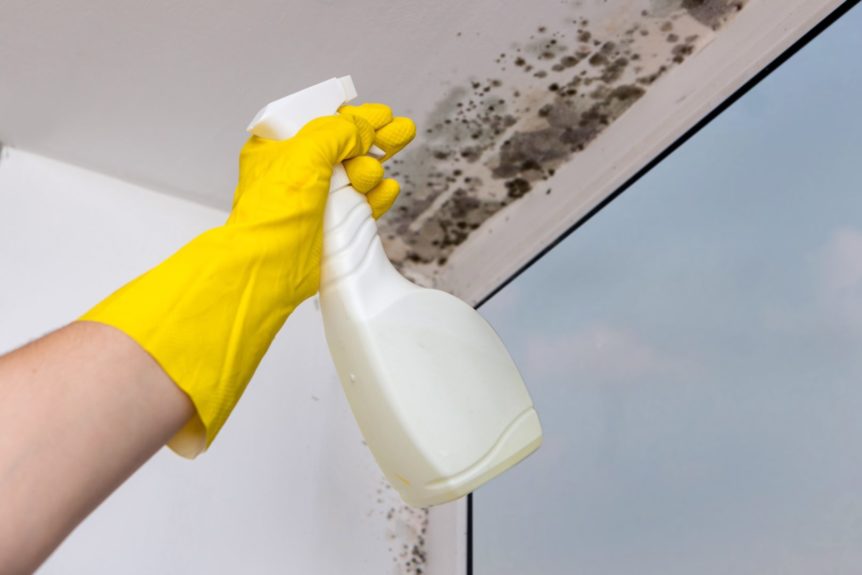
DIY How to Remove Black Mold
No one wants mold in their home, but unfortunately it makes an appearance from time to time, usually in the water-prone areas of our houses such as the bathroom and basement. To remove black mold, you’ll need to figure out why the mold is there to begin with. Once you know the cause, you can clean it up and then take the necessary precautions to keep it from coming back.
Target the Source
As mentioned, mold grows in wet environments. It’s important to find the source of the condensation and fix the problem. It may originate from a leak, improper ventilation, or blocked drainage. If you remove the mold without taking steps to dry up that space, it will come back. Once you fix the underlying issue, you are ready to clean up the black mold.
Protect yourself! Depending on the amount of mold you’ll be cleaning (and for the sake of this article, let’s assume it’s a decent amount), you’ll want to make sure you take the proper safety precautions. A list of items you may want to have on hand include:
- A face mask rated for black mold protection
- Heavy plastic to seal off the area and contain waste materials
- Heavy-duty plastic bags to collect wall material
- Duct tape to secure the plastic
- Fan
- Spray bottle with water to wet down dry areas to prevent mold spores from getting into the air.
- Pump mist sprayer filled with water to wet down larger areas
- Wood preservative
- Bucket
- Bleach or an Environmental Protection Agency-registered disinfectant cleaner
- Water
- Appropriate paint and painting tools
After securing the area with plastic and a fan if necessary, put on your face protection. Cover as much of your skin as possible to prevent the mold from touching you, and make sure to cover doorways and air vents with the plastic too. If possible, place the fan in a window to help vent the room. Again, all of this is depending on the amount of black mold that needs cleaning. Speaking of…
Figure Out How Much Mold There Really Is
Sometimes surface mold goes deeper than it appears so look closely at carpeting and padding, floorboards, drywall, and insulation. You need to know how much mold there really is in order to properly plan both removal and restoration.
Remove Carpet and Other Affected Items
Remove any wet, moldy porous items from the room. These may include books, furniture, and mattresses. Cut stained or musty smelling carpet into 6’x8’ squares and remove them (this size makes for easier replacement later). Wet the dry, moldy areas with the mist sprayer before removing them, as this will help contain particles in the carpet. Roll up the carpet, put in large plastic bags or pieces of plastic, and duct tape shut.
Check the Walls
Use a manual screwdriver poke a hole through any damaged areas of your wall to expose electrical wires before using a saw. Remove any affected baseboards and throw them out. (Safety tip: turn off your home’s power before cutting into any wall!) If the damage is apparent, cut into the drywall to check the area behind it; this also helps the wall dry. (Another safety tip: avoid cutting the now-exposed wires!) And remember to look for more than just black mold; any moisture that gets neglected will lead to rot. Wet any moldy drywall and its underlying insulation with the mister. Then remove, double bag, and duct tape shut. Also: cut out any damaged wood studs and sheathing. If this isn’t possible then clean the wood thoroughly, leave it exposed long enough to dry, and spray with a preservative.
Clean the Mold
Use an EPA-registered disinfectant cleaner on decks and fences to avoid damaging the wood. If you’re unable to acquire this, simply fill a bucket with one quart of water and 1/2 cup bleach. Work the solution into the surface areas and then allow them to dry naturally. It may take more than one cleaning to completely remove the mold.
Seal and Repaint
Once you’ve thoroughly cleaned all the areas, paint the wood and seal it with an oil-based primer or pigmented shellac. Prep and cover the walls with a latex paint designed to protect against mold growth.
If you are struggling to find the source of the mold or getting it removed, check out our mold remediation page!




